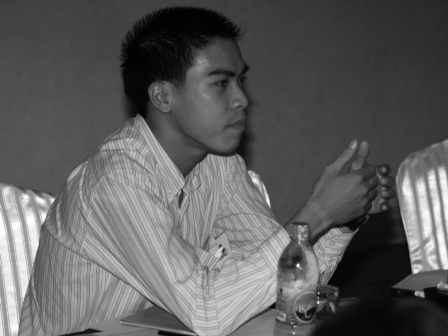Making the Case for Harm Reduction in Viet Nam
ACATA Member Addresses Drugs, HIV at U.S. Congressional Briefing
July 2007—The number of people living with HIV in Viet Nam has doubled since 2002. Addressing the alarming spread of the virus among injection drug users there, Duong Truong Thuy, a member of TREAT Asia’s Asian Community for AIDS Treatment and Advocacy (ACATA), provided an insider’s view of Viet Nam’s fight against HIV for a Congressional briefing in Washington, D.C., on 5 March. Thuy, who was unable to attend the briefing in person because of U.S. policy restricting visas for people with HIV, sent a written statement that was read at the event, portions of which are excerpted below.
My name is Duong Truong Thuy and I am 25 years old. I was an active injecting drug user (IDU) until five years ago. In 2003, I found out that I was HIV positive and shortly after I started ARV [antiretroviral] treatment. As a former IDU and an HIV community advocate, I hope I can convey to you my perspective on HIV and drug use in Viet Nam.

ACATA member Duong Troung Thuy provided an insider's view of Viet Nam's fight against AIDS for a Congressional briefing. |
In much of the world, in both economically developed and developing regions, IDUs are often considered second-class citizens. Because of this lack of inclusion and societal support, HIV/AIDS epidemics have been allowed to grow out of control within IDU populations.
In Viet Nam, the number of people with HIV/AIDS has doubled in recent years, and more than 60 percent of infected people are drug users, partners of drug users, and/or sex workers who also use drugs. In my country, as in many regions of Southeast Asia, HIV has spread rapidly through the IDU population. In the early 1990s, it was easy to get drugs and the price was low. As a result, thousands of people became addicted, including myself. Back then, the concept of harm reduction was not understood and harm reduction programs, including HIV prevention, treatment education, and community support for drug users, were unheard of. Around the mid-1990s, the Vietnamese government stepped up its anti-drug-trafficking enforcement and the price of drugs increased drastically. As a result, many people moved from snorting to injecting drugs. This was what happened to me.
A lot of people think “harm reduction” sounds criminal. But isn’t it more criminal when you know how to save people’s lives and you don’t do anything about it? Through harm reduction, we can prevent many more people—young people, wives, children, and IDUs—from getting HIV and even hepatitis C.
In Viet Nam, as in most parts of the world, drug use is addressed within the framework of criminality rather than as a treatable dependency and a medical condition. This attitude will not be changed until IDUs (active and former) are not the targets of stigma and discrimination. That flashed through my mind a year ago when I came to a hospital to ask for information about access to ARVs. The doctor asked me, “Have you ever used drugs?” My answer was yes, and so he said “These ARVs are for women, children, and others, but not IDUs.”
To significantly reduce the spread of HIV in Viet Nam and in the world, IDUs can no longer be overlooked or hidden. The urgent need to introduce and support harm reduction programs cannot be underestimated. Furthermore, we must put an end to stigma and discrimination, and recognize the contributions individuals with drug dependency can make to society. Now is the time to address this problem directly and immediately to prevent the spread of this destructive epidemic.
This Congressional briefing was sponsored by amfAR, Physicians for Human Rights, and the HIV Medicine Association.